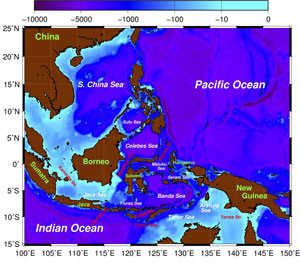
The passageway that links the Pacific Ocean to the Indian Ocean is acting differently because of climate change, and now its new behavior could, in turn, affect climate in both ocean basins in new ways.
University of Hawaiʻi at Mānoa physical oceanographer James Potemra is co-author of a study led by Janet Sprintall of Scripps Institution of Oceanography at UC San Diego. The study, “The Indonesian seas and their role in the coupled ocean-climate system” appeared in the June 22 advance online publication of Nature Geoscience.
The scientists have found that the flow of water in the Indonesian Throughflow—the network of straits that pass Indonesia’s islands—has changed since the late 2000s under the influence of dominant La Niña conditions. The flow has become more shallow and intense in the manner that water flows through a hose that has become kinked. The study suggests that human-caused climate change might make this characteristic a more dominant feature of the throughflow, even when El Niño conditions return.
Sprintall and colleagues have spent more than a decade understanding the dynamics of the throughflow, an ocean region that acts like a cable sending information between two electronic devices. The Indonesian seas are the only tropical location in the world where two oceans interact in this manner. The throughflow has an effect on the climate well beyond its boundaries, playing a role in everything from Indian monsoons to the El Niño phenomena experienced by California.
“This is a seminal paper on a key oceanographic feature that may have great utility in climate research in this century,” said Eric Lindstrom, a physical oceanography program scientist who co-chairs the Global Ocean Observing System Steering Committee at NASA, which funded Sprintall’s portion of the study. “The connection of the Pacific and Indian oceans through the Indonesian Seas is modulated by a complex circulation, climate variations and sensitive ocean-atmosphere feedbacks. It’s a great place for us to sustain ocean observations to monitor potential changes in the ocean’s general circulation under a changing climate.”
Sprintall, a physical oceanographer at Scripps Oceanography, said this new research starts a new chapter in the history of the throughflow, one characterized by the changed variables created by global warming.
“Now that we have a better understanding of how the Indonesian Throughflow responds to El Niño and La Niña variability, we can begin to understand how this current behaves in response to changes in the trade wind system that are brought on through anthropogenic climate change,” Sprintall said. “Changes in the amount of warm water that is carried by the throughflow will have a subsequent impact on the sea surface temperature and so shift the patterns of rainfall in the whole Asian region.”
Go to Kaunānā, the research publication for UH Mānoa, for the full story.
—By Talia Ogliore

